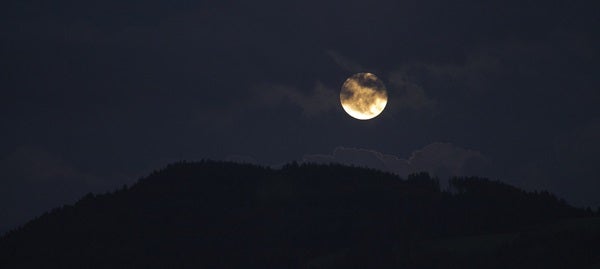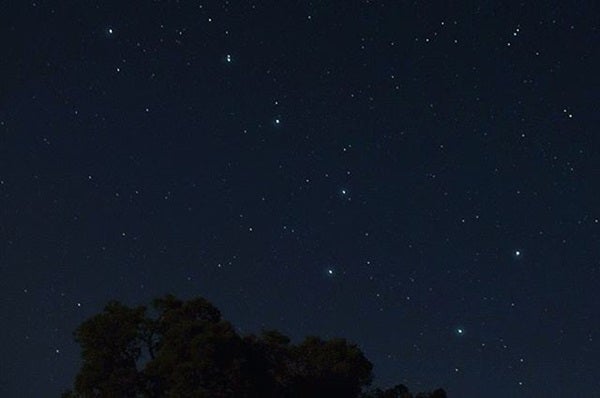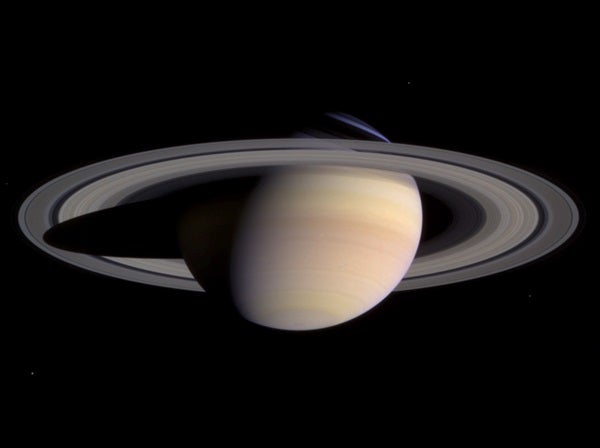Friday, July 7
Observers can catch a quick peek of Mercury in this week’s early evening sky. The innermost planet stands 6° high in the west-northwest a half-hour after sunset tonight, and it will gain another 2° of altitude by the end of the week. Although Mercury glows brightly this evening, at magnitude –0.6, you might need binoculars to spot it initially against the twilight glow. A telescope reveals the planet’s disk, which spans 5.6″ and appears 80 percent lit.
Saturday, July 8
Full Moon officially arrives at 12:07 a.m. EDT tomorrow morning, but it looks completely illuminated all night. It appears low in the southeast as the Sun sets and climbs highest in the south around 1 a.m. local daylight time. The Full Moon resides among the background stars of Sagittarius the Archer throughout the night.
Sunday, July 9
Tonight marks the peak of Pluto’s 2017 appearance. The distant world reaches opposition, which means it lies opposite the Sun in our sky and remains visible all night. It glows dimly at 14th magnitude, however, so you’ll need an 8-inch or larger telescope with good optics to spot it visually. Pluto currently lies in northeastern Sagittarius, some 1.8° east-southeast of 3rd-magnitude Pi (p) Sagittarii. See “In pursuit of Pluto” in the July Astronomy for complete details on finding this world.
Monday, July 10
By the time morning twilight starts to paint the sky, brilliant Venus already dominates the scene. And this morning it looks particularly stunning perched directly between the Pleiades and Hyades star clusters in Taurus the Bull. (The planet continues to trek north of the Hyades during the next several days.) Although Venus reached its greatest elongation from the Sun more than a month ago, it now rises earlier and climbs higher before dawn. It pokes above the horizon at 3 a.m. local daylight time and stands nearly 20° high in the east an hour before sunup. It’s hard to mistake the inner planet for anything else — at magnitude –4.1, it shines brighter than any other point of light in the sky. When viewed through a telescope this morning, Venus shows an 17″-diameter disk that appears two-thirds illuminated.
If you have clear skies tonight, you should be able to detect Pluto’s motion relative to the background stars as it skims north of magnitude 8.2 SAO 187913 and its magnitude 9.8 neighbor. These two stars lie 37″ apart and provide a convenient yardstick for locating the solar system world. At 9:30 p.m. EDT, Pluto appears 29″ due north of the brighter star. Its westward motion during the course of the night carries it closer to the fainter companion. Pluto lies 23″ northeast of this star at 12:30 a.m., and just two hours later, the gap shrinks to 16″. It passes only 7″ due north of the star at 6:00 a.m.
Tuesday, July 11
Jupiter appears more than one-third of the way to the zenith in the southwestern sky during twilight this week and doesn’t set until after midnight local daylight time. The brilliant planet shines at magnitude –2.0 and dominates the evening sky until the Moon rises. It appears against the backdrop of Virgo, some 10° northwest of the Maiden’s brightest star, 1st-magnitude Spica. When viewed through a telescope, Jupiter’s disk spans 36″ and shows a wealth of atmospheric detail.
Wednesday, July 12
The Big Dipper’s familiar shape lies high in the northwest as darkness falls these July evenings. One of the summer sky’s finest binocular double stars marks the bend of the Dipper’s handle. Mizar shines at 2nd magnitude, some six times brighter than its 4th-magnitude companion, Alcor. Even though these two are not physically related, they make a fine sight through binoculars. (People with good eyesight often can split the pair without optical aid.) A small telescope reveals Mizar itself as double — and these components do orbit each other.
Thursday, July 13
The next few nights offer a wonderful opportunity to track down asteroid 6 Hebe through a telescope. The 9th-magnitude object lies in Ophiuchus the Serpent-bearer and passes just south of a pair of 6th-magnitude stars: SAO 141585 and SAO 141611. If you sketch the field tonight and then return to the same area over the upcoming weekend, you should be able to detect Hebe’s movement relative to the stellar background.
Friday, July 14
Venus passes 3° due north of 1st-magnitude Aldebaran this morning. Although the star ranks among the 15 brightest in the entire sky, the planet appears 100 times brighter. Aldebaran marks the ruddy eye of Taurus the Bull and forms one tip of the V-shaped Hyades star cluster. Aldebaran only appears to be a cluster member, however — it actually lies only about half as far away as the Hyades.
Saturday, July 15
Although Saturn reached its peak a month ago today, when it appeared opposite the Sun in the sky, our view of the ringed planet remains spectacular. It resides against the backdrop of southern Ophiuchus, a region that climbs highest in the south around 11 p.m. local daylight time. Saturn glows at magnitude 0.2 and easily outshines the background stars. When viewed through a telescope, the planet’s globe measures 18″ across and the dramatic ring system spans 41″ and tilts 27° to our line of sight.
Sunday, July 16
Last Quarter Moon occurs at 3:26 p.m. EDT. Look for it either before dawn this morning (when it looks slightly more than half-lit) or after it rises around 1 a.m. local daylight time tomorrow (when it appears as a fat crescent). Earth’s only natural satellite straddles the border between the relatively inconspicuous constellations Pisces the Fish and Cetus the Whale.












